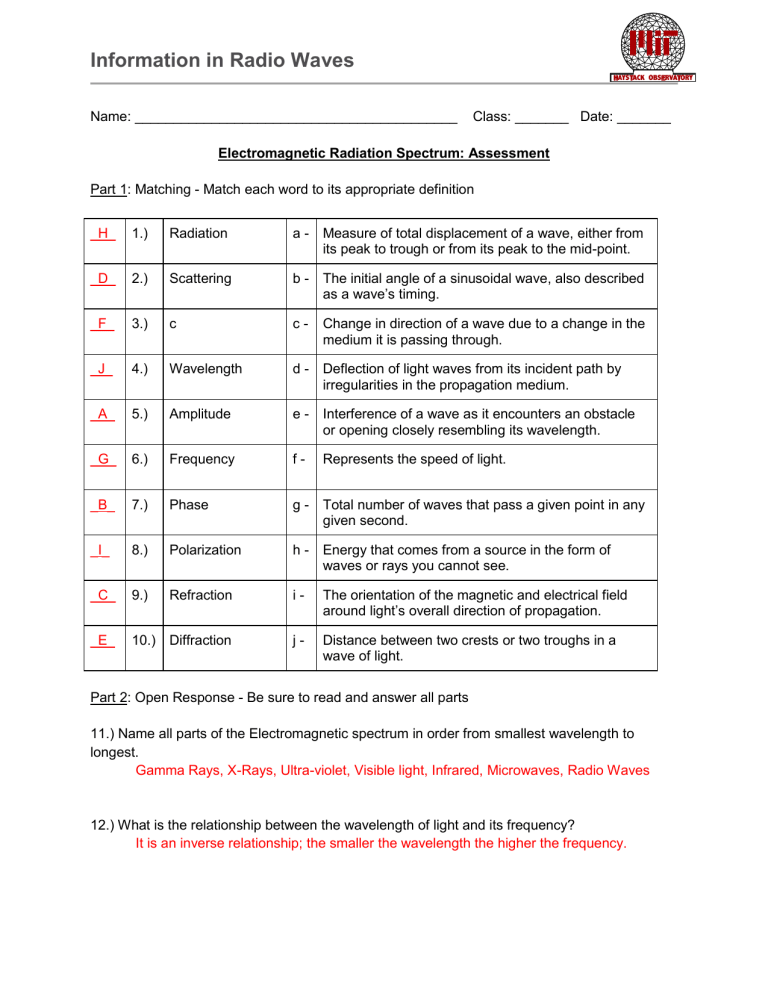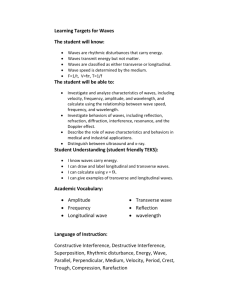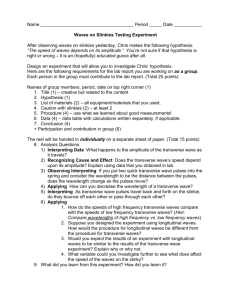docx - MIT Haystack Observatory

Information in Radio Waves
Name: __________________________________________ Class: _______ Date: _______
Electromagnetic Radiation Spectrum: Assessment
Part 1: Matching - Match each word to its appropriate definition
_H_ 1.) Radiation a - Measure of total displacement of a wave, either from its peak to trough or from its peak to the mid-point.
_D_ 2.) Scattering
_F_ 3.) c b - The initial angle of a sinusoidal wave, also described as a wave’s timing. c - Change in direction of a wave due to a change in the medium it is passing through.
_J_ 4.) Wavelength
_A_
_G_
_B_
_I_
5.)
6.)
7.)
8.)
Amplitude
Frequency
Phase
Polarization d - Deflection of light waves from its incident path by irregularities in the propagation medium. e - Interference of a wave as it encounters an obstacle or opening closely resembling its wavelength. f - Represents the speed of light. g - Total number of waves that pass a given point in any given second. h - Energy that comes from a source in the form of waves or rays you cannot see.
_C_ 9.) Refraction i - The orientation of the magnetic and electrical field around light’s overall direction of propagation.
_E_ 10.) Diffraction j - Distance between two crests or two troughs in a wave of light.
Part 2: Open Response - Be sure to read and answer all parts
11.) Name all parts of the Electromagnetic spectrum in order from smallest wavelength to longest.
Gamma Rays, X-Rays, Ultra-violet, Visible light, Infrared, Microwaves, Radio Waves
12.) What is the relationship between the wavelength of light and its frequency?
It is an inverse relationship; the smaller the wavelength the higher the frequency.
Information in Radio Waves
13.) Describe the differences between a transverse wave and a longitudinal wave.
Transverse waves travel perpendicular to wave displacement, longitudinal travel parallel.
Transverse waves exhibit a characteristic wavelength and amplitude, whereas longitudinal consists of compressions and rarefactions.
14.) Name three possible polarizations of light.
Vertical, Horizontal, Circular, and Elliptical.
15.) Describe the major differences between light waves and sound waves.
Sound requires a medium to travel, light does not. Sound is a longitudinal wave, light is a transverse.
16.) Compare and contrast the two equations:
V = d / t C = f * 𝜆
Answers will vary.
17.) How is refraction different from diffraction.
When light diffracts, it is affecting by an object or opening similar in wavelength. When it refracts, it is changing direction as it travels through mediums of different material.
18.) Give a brief summary of why the sky appears blue. Be sure to explain why it also appears yellow/red during dusk and dawn.
As light passes through the atmosphere, light is scattering in all directions off the molecules that comprise the air. It’s blue because blue light scatters more easily due to it being a shorter wavelength. At dusk and dawn, light must travel through more atmosphere to reach your eyes. By the time it reaches your eyes, all or most of the shorter wavelengths have been scattered leaving only the longer red wavelengths.
19.) If two light waves are “in phase” with one another, what will happen? What if they are slightly out of phase? Completely out of phase?
If in phase, they will add and overall have a higher amplitude. If only slightly out of phase, they will add less. If they are completely out of phase they will cancel out.
20.) When doing a single-slit or double-slit experiment, how do you determine the size of the hole? Why?
You determine the size of the hole based on the wavelength of the light passing through it. If it isn’t approximately a whole number ratio to the wavelength it will not interfere with the light.









